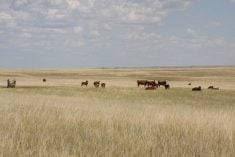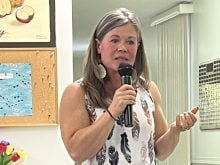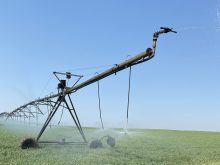‘Alberta is just not equipped to get through two years of drought, not with the mountain water supply,’ says researcher
Nearly $1 billion in funding for irrigation expansion in southern Alberta has been announced during the past two years with the potential to boost the region’s acres under pivot by 15 percent.
However, this season’s reductions in water allocations due to low river levels, has cast doubt on what the impacts will be of potentially adding more than 200,000 acres to the irrigation system.
“Alberta is just not equipped to get through two years of drought, not with the mountain water supply,” said John Pomeroy, University of Saskatchewan professor and Canada research chair in water resources and climate change.
Read Also

Huge Black Sea flax crop to provide stiff competition
Russia and Kazakhstan harvested huge flax crops and will be providing stiff competition in China and the EU.
“If we had another spring like this and another dry summer, it would be quite a serious situation for the irrigators, for the cities, for the trout in the streams and we still have obligations to pass on certain flows to Saskatchewan.”
The primary sources of Alberta’s irrigation water supply come from the Oldman and Bow rivers and their tributaries, which are running well below the bottom range of historical flow rates for the traditionally peak period in June.
In 2006, the Alberta government placed a moratorium on granting new water licences that draw water from the two rivers because of over allocation of the water supply along with the South Saskatchewan, which starts at the confluence of the two rivers.
In the decade following that decision, irrigation districts have improved efficiencies by converting many smaller open canals to underground pipelines and farms have installed new irrigation pivot technology.
But the system heavily depends on the spring melt of the mountain snowpack, which recharges the network of reservoirs.
This year, that snowpack was well below average and the traditional spring deluge of precipitation never happened.
Pomeroy pointed out that unlike the irrigation reservoirs fed by the Colorado River in the United States, which are built to withstand a 10-year drought, Alberta’s are more limited in capacity.
“Essentially, all of our reservoirs are far smaller than anything down south in the States,” he said. “We won’t have 10 years. Basically, after two years, we have to shut down everything.”
Richard Phillips, chair of Irrigating Alberta, a consortium of irrigation districts managing the expansion projects, said the system is a balancing act.
“If you never have a shortage, perhaps you really aren’t utilizing the resource as much as you ought to because that means a lot of years there’s water that you could be using for beneficial use that isn’t being used,” he said. “The other side of the coin is that people say there should never be a shortage. We are irrigation farmers because we want to be guaranteed all the water every year.”
Those management decisions are up to irrigation districts and its stakeholders to make, said Phillips.
“If you are going to improve your water supply, it can either improve water security for what’s already there or it can support additional irrigation or a combination,” he said. “The new off-stream reservoirs or expansions of off-stream reservoirs, which are part of the modernization program, they will enhance water security. And two of the three districts, Eastern and St. Mary’s, have already approved expansion plebiscites so, clearly, at least a portion of improved storage there is going to expansion.”
Phillips, who is also general manager of the Bow River Irrigation District, said his district is committed to irrigation expansion but said it might be a tough sell to stakeholders if there are a couple of tough water supply years.
Both Eastern and St. Mary’s irrigation districts have reduced their allotments this year while Bow River has maintained theirs, although it will draw down reservoir storage.
Trouble could be brewing as pressure on the system continues, especially from growers of high water demand crops like potatoes, corn, alfalfa and sugar beets, according to Ross McKenzie, retired Alberta Agriculture crop and soil research scientist.
Of the three factors that make up the calculation of water needs of a crop — soil moisture, precipitation and irrigation — the latter two are in short supply.
“Alfalfa and corn will need upwards of 24 to 26 inches of water so the longer season, higher water-use crops will be more of a challenge and that really is where the problem comes in,” said McKenzie.
An expansion of irrigation systems could set up farmers for tough times ahead.
“In my opinion, one out of 10 years you’re going to have a year like this and another two or three years out of 10 you’re going to be a bit below normal,” he said. “The more acres we irrigate, in reality, the more potential problems we are going to have.”
Pomeroy said current environmental modelling shows significant declines in the amount of the mountain snow coverage. While overall precipitation levels over the long term are expected to remain the same, it will be an average of extremes rather than through consistency.
Pomeroy said this year is especially unique because hot temperatures seen this spring weren’t expected until later this century under climate change modelling.
“But it showed an increase in rainfall as well and we have not seen that,” he said. “We haven’t seen it this year and we haven’t seen a trend for increased rainfall in the mountain headwaters yet and that’s a concern. This is maybe what future climate in a drought year looks like for us and it’s something really different.”
Pomeroy also stated the snowpack melt this year has been the fastest he and other have ever seen.
Alberta has nearly 1.5 million acres under irrigation, which makes up close to three-quarters of all water allocated from the Bow and Oldman rivers.


















